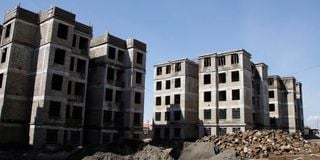Here’s what urban dwellers can borrow from Gen Z’s use of tech to advocate for their right to decent housing

Work in progress at the Affordable Housing Project in Elburgon, Nakuru County, on July 12, 2024.
What you need to know:
- Kenya’s urban policies continue to prioritise the demands of the middle and upper classes over the needs of poorer groups.
- Urban upgrading projects meant to address the needs of marginalised groups have failed to do so.
Since the first master plan for Nairobi was published in 1948, Kenya’s capital city has continued to be marred by a lot of inequality, with the haves seemingly enjoying living and working conditions that the have-nots can only dream of.
When the 1948 plan was developed, neighbourhoods in the west were designated for specific races, including whites and Asians, while land east of the railway station was set aside for industrial development and for working natives.
After independence, several plans were later developed to address these inequalities, the most notable one being the 2015 Nairobi Integrated Urban Development Master Plan (Niuplan).
However, none of these have led to much change in the levels of service provision and planning in urban areas, as the 1948 ‘Master Plan for a Colonial Capital’, still highly defines how the city appears today.
The same is true for other towns in Kenya, where urbanisation is highly elitist and oppressive of the needs of marginalised groups such as informal traders, women, youth and persons living with disabilities.
Smart cities
"When you look at most images of smart cities, they always depict shiny buildings and you rarely see the people element," says Titus Kaloki, a programme coordinator at Friedrich-Ebert-Stiftung Kenya.
Indeed, Kenya’s urban policies continue to prioritise the demands of the middle and upper classes over the needs of poorer groups, with inequalities being most evident in the housing and public transport sectors.
The majority of urban populations continue to live in unplanned informal settlements, where living conditions are extremely dire with little to no access to basic services.
Urban upgrading projects meant to address the needs of marginalised groups have failed to do so, with programmes such as affordable housing being criticised for failing to factor in the needs of persons living with disability.
"It comes down to the small things like the tiles that you are using- can someone with crutches walk through them safely?" posits Kaloki.
In addition, public transport in urban centres is unsustainable and unaffordable for the majority, as public transport provision has been left largely to the private sector.
"Urban policy makers plan for car-owning residents and motorised transport, not for pedestrians and cyclists. Hence the emphasis on highways and road infrastructure, not on bicycle and pedestrian pathways," says Kaloki.
Limited participation
These missing links can be attributed to limited participation of residents, particularly the marginalised groups, in urban planning processes, despite various provisions under Kenya’s laws for citizen participation.
Parties such as informal traders, non-motorised residents, women, youth, children and persons with disability, remain unrepresented in urban plans and programmes, and are often only considered through tokenistic approaches.
Urban boards mandated with representing the interests of these people often comprise members who do not understand their needs and are therefore ineffective. In those boards, there is also a lot of choreographed participation.
"Other times, the county and city boards will tell you that they are starved of resources and therefore can only do a certain number of workshops in a week. This leaves out the people who work 8-5 jobs," says Kaloki.
Seemingly, planning in Kenya has taken a top-down approach, where business interests and funding supersede the interests of residents, particularly low-income residents, who form the majority of the urban population.
"There is a big gap in terms of seeing communities as partners. The kind of frustrations neighbourhood associations are going through putting across their aspirations needs to be addressed urgently," notes Kaloki.
The mainstream media has also been accused of failing to highlight the plight of these people, opting instead to cover sensational stories that are likely to resonate with their audiences.
Technology
"There is a need to encourage people to embrace other formats of participation, leveraging on technology for instance. Gen Zs have just taught us how this can be done," says David Gatimu, an expert planner.
Going by the current happenings in the country, Gatimu says that social media can be adopted as an effective tool for improving the process of public participation.
For example, technology can be used to create 3D displays of neighbourhoods that can be shared with residents who then can share ideas on where they would prefer certain amenities to be, based on their living conditions.
"For instance, on the 3D model, the residents can drag and paste street lights to areas where they feel there might be issues of insecurity in their neighbourhood," says Gatimu.
At no cost, urban residents can also leverage technology to analyse and report on what is going on in their neighbourhoods, as an alternative to using crowd-sourced data.
Using technology, they can also hold virtual barazas to engage in conversations around planning processes for a better understanding of how these could affect their lives.
"Many citizens are not aware that they have a responsibility to take part in planning processes. These are the spaces where development is shaped, and resources are allocated and spent, therefore citizens must occupy these spaces and use them effectively," says Gatimu.
Just as some plans are made using GIS tools, on a hand-held device, residents should also be able to interrogate any development that is coming up within their neighbourhood, with images being taken and sent to the authorities in real-time if a building falls short, for prompt action.
Development parameters
"We need to get to a point where local plans are broken down in a simplified way so that every resident of the city is able to know what the development parameters in the zone where they live are," says Gatimu.
Similarly, investors intending to purchase a parcel of land for development should be able to digitally identify what is permissible in a certain area and whether that zone has any limitations.
"We have had too many cases of investors buying land only to hear that it has limitations and they may have to seek political redress to circumvent what the plan of that zone allows," says Zoravar Singh, a director at the Kenya Property Developers Association.
Different government agencies, including the departments of health, urban planning and housing, and environment can also leverage technology to work collaboratively.
"There is this challenge we find on the ground where there is a lack of policy coherence and project collaboration, by those who are actually supposed to provide public goods and services," says Zoravar.
Many times, this confusion between various government departments slows down implementation and reduces the collaboration that could optimise resources and deepen the impact.
"We must start thinking about how we bring these actors and other stakeholders, including the private sector, together to bring policy coherence and collaborate on projects," notes Zoravar.
Technology can also be used to bridge the gap between development partners, donors and well-meaning organisations in civil society, who oftentimes work in silos preventing them from having complimentary coordination.
"We are all trying to solve the same problems but separately which leads to duplication, wastage of resources and also creates confusion amongst our intended beneficiaries as to who exactly is supporting them and how," notes Kaloki.
Counties can map all their development partners to know what they are supporting, how it is complementary to what the other person is doing and try to introduce the two to create some synergy.
Digital participatory tools can then be utilised by the county governments to reach out to the most vulnerable and voiceless in their communities to give their views on projects done by these partners.
"People need to be allowed to participate in decision making so that we do not have inclusive access to public goods and services as the outcome of benevolence of a leader but rather as an outcome of citizen participation," says Emma Miloyo, an architect.
Inherently, Emma notes that all human beings are aspirational, with an understanding of what a good space should look like.
"When you look at what people in successful cities like Copenhagen and Melbourne have been able to achieve in a short period of say 20, 30 years, there is a lot that we can learn in terms of listening to the voice of the people," notes Miloyo.
However, while there continues to be a lot of advocacies for proper development across various avenues in Kenya, lack of action from the authorities or poor dispute resolution mechanisms continues to be a thorn in the flesh.
"In Kilimani and Kileleshwa for instance, how many complaints have been put across to the authorities on discordant developments that are coming up and nothing is being done?" posits Miloyo.
In many cases, she notes that complaints are raised even before developments begin, but by the time the matter reaches the liaison stage, the buildings are occupied, begging the question of whether such impediments are deliberate.
Corruption and informality in the enforcement of plans are also major issues, where for instance no enforcement notices are served to the residents in what often appears like a deliberate move to impede public participation.
Correct mechanisms
"At times the officials know very well that a plan or development is falling short of what is required, but still, you find them coming to enforce without following the correct mechanisms," says Miloyo.
She notes that what is happening on the ground is that a lot of political and commercial interests are superseding those of the community and this needs to stop.
"We are at a point in time where if you ignore the voice of the people, things will crack. With the young people coming up, you cannot just force things down people’s throats anymore," says Miloyo.
She gives an example of when Nairobi governor Johnson Sakaja was questioned as to why he lifted the number of floors allowable in neighbourhoods such as Kilimani, Kileleshwa and Eastleigh.
He responded that he had engaged the President on the matter and not the community that resides there.
"We understand that there is pressure for densification closer to the CBD where it is not sustainable to have single dwelling units. However, can development be done with the interests of the community in mind?" posits Miloyo.
Whether they like it or not, Emma notes that authorities in the planning processes, governance and politics will need to start listening to the people, to achieve sustainable development in urban centres.
"People are saying that we are the ones who live in these neighbourhoods, we understand the dynamics better, therefore it cannot be that someone else from outside makes key decisions in our place," says Miloyo.





